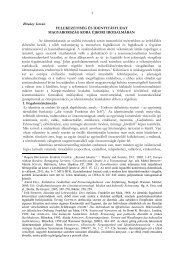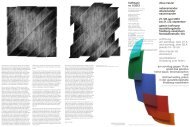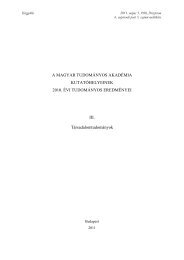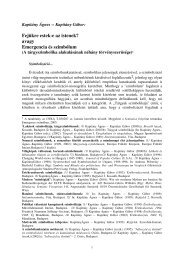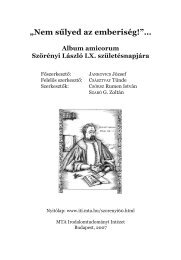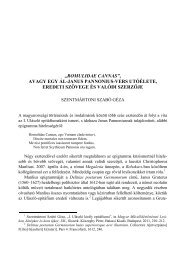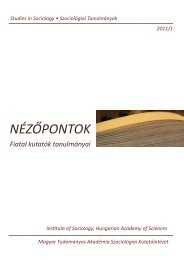symbolic elements of everyday culture - MTA Szociológiai ...
symbolic elements of everyday culture - MTA Szociológiai ...
symbolic elements of everyday culture - MTA Szociológiai ...
You also want an ePaper? Increase the reach of your titles
YUMPU automatically turns print PDFs into web optimized ePapers that Google loves.
● KAPITÁNY ÁGNES – KAPITÁNY GÁBOR ● Theses about “Kadarism” ●<br />
several reports revealed, a declared expanded scope <strong>of</strong> movement in fact increased self-censorship: we are<br />
allowed to say whatever we want, if only in a limited way and in main terms, so we do not need to<br />
undertake open confrontation.)<br />
Even a disarmed adversary will remain a foe. Moreover, by simultaneously oppressing both past and present,<br />
the regime proliferated in adversaries: some challenged it on account <strong>of</strong> the withering past, others, on account<br />
<strong>of</strong> the present.<br />
The era <strong>of</strong> „national unity” <strong>of</strong> Kadar was limited by two quasi division (in fact if we look beyond the narrow<br />
sense boundaries <strong>of</strong> the period, it separates two quasi national unities). The two lines <strong>of</strong> quasi division are<br />
Kadar's ascent to power at the end <strong>of</strong> 1956, and his funeral. Public opinion differs on both counts. We can<br />
recall the war <strong>of</strong> billboard slogans in late 1956 („Long Live Kadar”, „Long Fear Kadar”, „Don't Fear Kadar”,<br />
„Why shouldn't Kadar Fear?” „Kadar Shouldn't Fear for Anything” . In Hungarian: “Éljen Kádár – Féljen Kádár<br />
– Ne féljen Kádár – Miért ne féljen Kádár – Semmiért ne féljen Kádár. = The text was becoming longer every<br />
day). The funeral <strong>of</strong> Janos Kadar was a response to the memorial funeral <strong>of</strong> Imre Nagy. Apparently, both<br />
events gave rise to a similar division <strong>of</strong> the population as a civil war: Kadar's supporters on this side,<br />
adversaries on the other. This, however, is only a quasi-division: in the first case Kadar was not yet an<br />
alternative, while at the time <strong>of</strong> his burial he was obviously no longer one. In 1956, Kadar relying on realist<br />
middle classes and thereby creating „national unity” was the standard <strong>of</strong> an extreme stratum whereas at the<br />
time <strong>of</strong> the political changeover he was a mere memory <strong>of</strong> stability. (Obviously, the overall accord prior to<br />
1956 and in 1989 wishing for a political change with unanimous will was also an indication <strong>of</strong> a quasi-unity. In<br />
both 1956 and 1989, the unanimous wish for a change in fact denotes a multitude <strong>of</strong> aspirations, sometimes<br />
opposite in nature.) In this respect, Kadar managed to create a relative social peace at the end <strong>of</strong> the first third<br />
<strong>of</strong> the interim period because his „realistic” conservatism disregarded the new momentum <strong>of</strong> co-operative<br />
organisation and the consequent racing urbanisation, it leaves the components <strong>of</strong> „the social structure”<br />
essentially intact. (His „realistic” alignment towards the centre is also marked by his ability to make future-<br />
oriented strata accept the idea that he progresses and at the same time he could convince past -oriented<br />
groups <strong>of</strong> his intent to use viable <strong>elements</strong> <strong>of</strong> the past, while his real aspirations in fact aimed at neither<br />
direction.)<br />
The policy <strong>of</strong> „realism” had a major drawback. Once it loses power, it loses the very essence <strong>of</strong> legitimacy; a<br />
realist who is no longer able to exercise power is not a realist any more.<br />
A much analised tactic <strong>of</strong> the Kadar era was the fragmenta tion <strong>of</strong> society, locking individuals in<br />
micro worlds. This individualisation obviously helped society to turn towards capitalism, as the<br />
existing capitalism was more advanced in terms <strong>of</strong> living standards as well as the development <strong>of</strong><br />
individuality and the scope <strong>of</strong> individual movement compared to the sophisticated (administrative<br />
economist) socialism. In the battle in the individual's soul it is capitalism that wins. Kadar himself<br />
and his closest followers obviously never thought <strong>of</strong> the restoration <strong>of</strong> capitalism. Still it is not an<br />
accident that the economist and sociologist elite supporting Kadar and in their wake, the apparatus<br />
becoming more and more „enlightened” in fact made decisions which pointed in that direction<br />
essentially almost from the very beginning.<br />
Ultimately, the politics whose major goal was the stabilisation <strong>of</strong> the regime grew the basis <strong>of</strong> its<br />
own destabilisation: Hungary saw the evolution and ultimate conclusion <strong>of</strong> processes which in<br />
28




